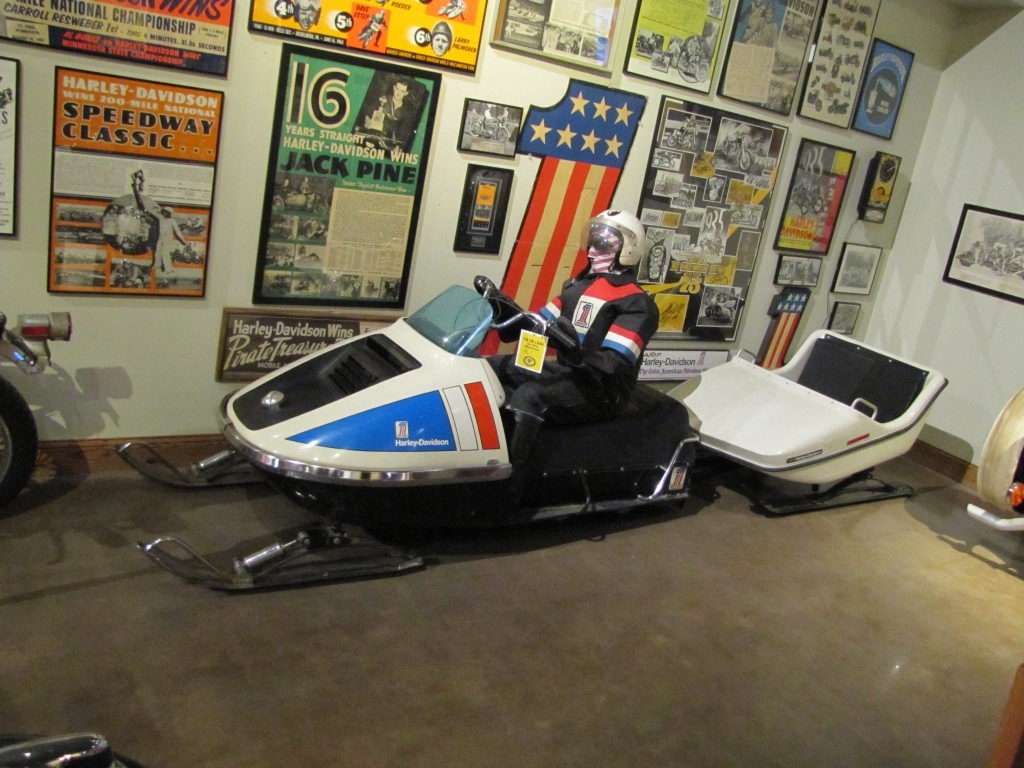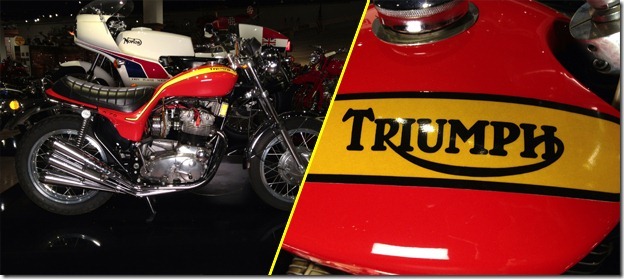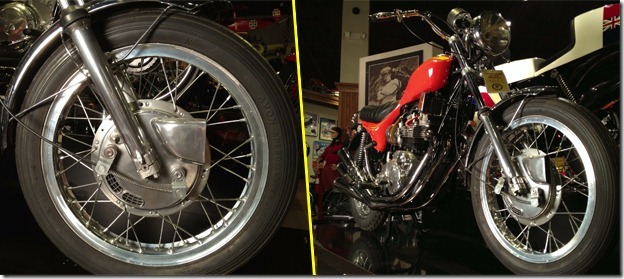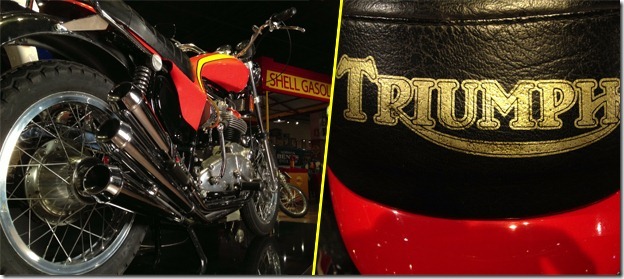Featured Machine: Harley-Davidson Snow Mobile
/6 Comments/in Featured Bike/by wedadmin
We thank David Borre for loaning his 1972 Harley-Davidson Snowmobile and rare matching snow “trailer” for display at the National Motorcycle Museum.
At 110+ years of age Harley-Davidson must be counted among America’s most successful and long lasting corporations. But looking back into the 1960’s and 1970’s there were partnerships, buy-outs and product experimentation that, in hind sight, were not always well thought out.
Looking for new ways to make use of technology, manufacturing capability and existing distribution channels, several powersports corporations ventured into the world of snow machines. AMF, American Machine Foundry, at that time soon to be the owner of Harley-Davidson and many other brands, was among them. An internal written study for AMF dated in 1964 offered “Proposed Specifications for the AMF Snow Sled.” It presented the huge growth potential of the snowmobile market and specs for AMF’s proposed concept vehicle. The study said the sled should feature a front-mounted two cycle engine, rugged drive belt, top speed of 25 mph, smooth and flowing styling, be lightweight, comfortable and focus on dependability. In 1965 AMF Western Tool made the decision to proceed with the new AMF snowmobile and production came fast!
Through 175 dealers, 3000 units were sold in 1966. After AMF’s acquisition of Harley-Davidson in 1969, the facility in York would produce Harley-Davidson motorcycles and snow machines. Then, making use of their recently acquired power-house brand, in late 1971, AMF made the decision to again re-design and re-brand their snow mobile line.
They dropped the Ski-Daddler name in favor of the hugely popular Harley-Davidson brand.
A handful of 1971 Harley-Davidson Snowmobiles were produced and the 1972 model year was the first full year for the Harley-branded sleds and the last for the Ski-Daddler sleds, both AMF offerings. Harley-Davidson dealers were offered the Harley snowmobile line as a separate product and some former Ski-Daddler dealers were also offered Harley snowmobile franchises. Promoting the brand, the Harley-Davidson sleds were advertised as using Harley engines, two-stroke singles which were conveniently sourced through the Italian Aermacchi connection; Harley had bought 50% of Aermacchi about 1960.
It was believed by AMF that they would sell more snowmobiles through the Harley-Davidson network with the Harley name. Soon the Harley sleds were assembled at the company’s Oak Creek, Missouri facility, sharing production facilities with the Harley-Davidson (AMF) golf cart. But, at the end of the 1975 snowmobile model year, it was announced that production of AMF Harley-Davidson snowmobiles would be discontinued. The eight year experiment had not been much of a success. And to complete the picture of that era in Harley-Davidson history, in 1981 Willy G. Davidson, Vaughn Beals and 11 other partners bought the company back from AMF. After a few tough years refocusing and rebuilding the company, profitability came in the late 1980’s.
The Sno-Clipper, Power Sled, Ski-Daddler and Harley-Davidson snowmobiles have remained popular with vintage collectors. We thank David Borre for loaning his 1972 Harley-Davidson Snowmobile and rare matching snow “trailer” for display at the National Motorcycle Museum.
1972 Triumph X75 Hurricane
/0 Comments/in Featured Bike/by wedadmin
It seemed to hit all at once. In 1967 a big, high performance bike was a 650 Triumph or a Harley Sportster. Then all hell broke loose about 1968 with the Norton Commando Fastback, and soon after the 750cc Triples from BSA and Triumph followed by the Honda CB750 and H1 Kawasaki. By 1973 there were the H2 and then Z1 Kawasakis, and the Suzuki GT750 Triple thrown in for a little flavor. Never had motorcycling seen such rapid evolution, and one-upsmanship in such a short period of time. In 1969 in an effort to extend the niche of the new BSA Triple, the Rocket III, and keep up with the pace of change, American designer Craig Vetter was given a BSA Rocket III to experiment with. The fantastic X75 Hurricane was the result.

BSA was out of business by 1973 and Norton was nearing its end. Competition from Japan was strong. The American market was extremely important to British bike manufacturer Triumph. It’s said that what Triumph was after was a chopper version of its 750cc triple to feed the styling trend fueled by Easy Rider; extended front ends, skinny front wheels and upswept exhaust were happening in the motorcycle scene. But working in glass fiber reinforced resin and plenty of chrome, schooled and knowing Craig Vetter gave them instead a more lasting look.

The standard Rocket III’s front end was slimmed by removing the fork gaitors and using an abbreviated chromed fender with light wire stays. Keeping the headlight high adds to the impression of long forks, which were extended about an inch over stock. The fuel tank, a sleek but too small two and a half gallon sculpture necked down to transition into integrated side-covers, then a seat pan. Upswept exhausts add motion and visual weight to the rear of the bike, though right side ground clearance was a problem.
A somewhat impractical styling exercise that hit late in the reign of the British motorcycle, more expensive than a standard Triumph Triple, the Hurricane was slow to sell. About 1200 Hurricanes were made. They are now highly collectible for their unique style by an American designer, Craig Vetter, and today prices are increasing rapidly.
| Specifications | |
| Engine | OHV Three Cylinder |
| Bore & Stroke | 67mm x 70mm |
| Displacement | 744cc’s |
| Carburetors | Thre 27mm Amals |
| Horsepower | 58 |
| Primary | Duplex Chain |
| Transmission | 5-Speed |
| Electrics | 12 Volt |
| Suspension | Telescopic Fork / Dual Shock, Swingarm |
| Wheels/Tires | 3.25 x 19 / 4.25 x 18 |
| Wheelbase | 57 Inches |
| Brakes | Drum; 200mm / 175mm |
| Weight | 465 Pounds |
| Top Speed | 115 MPH |
On Loan to the National Motorcycle Museum from Jerry Rewerts – L35

Pages
- 13th Annual East Central Iowa Sidecar Rally
- 14th Annual East Central Iowa Sidecar Rally – Sept. 9, 2017
- 1909 Royal Pioneer
- 1912 Pierce Four
- 1914 Yale Twin
- 1923 Ner-A-Car Model A
- 1936 Harley-Davidson VLD
- 1939 Harley-Davidson EL "Piston Splitter"
- 1948 Indian Scout "Big Base"
- 1951 HD FL Cop Bike
- 1952 Vincent "Red" Rapide
- 1954 Harley-Davidson John Tibben's KR750 Dirt Track Racer
- 1955 Goggo 200 DeLuxe Scooter
- 1957 BSA Gold Star DBD34 Flat Tracker
- 1970 Vesco Engineering Yamaha Twin Streamliner
- 1977 Harley-Davidson XLCR
- 1990 XR1200 Jesse James Custom
- 2002 Winner
- 2003 Winner
- 2004 Winner
- 2005 Winner
- 2006 Winner
- 2007 Winner
- 2008 Winner
- 2009 Winner
- 2010 Winner
- 2011 Winner
- 2012 Motorcycle Cannonball
- 2012 Vintage Bike Show
- 2012 Vintage Rally
- 2012 Winner
- 2013 Vintage Rally
- 2013 Winner
- 2014 Winner
- 2015 Winner
- 2016 Winners
- 2017 Winners
- 2018 Winners
- 2019 Winners
- 2020 Winners
- 2021 Winners
- 2022 Winners
- About
- Allstate Motorcycle Insurance Quarter MileStones
- And the Winner is…
- Barn Find
- Baxter Cycle Annual Open House and Motorcycle Auction, August 20, 2016 – Saturday Only
- Bessie Stringfield, Southern Distance Rider
- Best of the Best Gallery
- Careers
- CHOPPER STORY and 2 WHEELS+MOTOR
- Closing out March, Women's (Motorcycling) History Month…
- COMING SOON
- Davenport AMCA Swap Meet 2012
- David E. Allison Memorial Ride – June 17, 2017
- Dirt Riding USA, presented by J&P Cycles
- Distinguished Gentlemans's Ride
- Donate to the National Motorcycle Museum
- Donations/Gifts
- Donnie Smith Bike & Car Show, St Paul, Minnesota, April 2-3, 2016
- Early American Transportation Innovation
- Featured Articles
- Featured Bike: 1972 Triumph X75 Hurricane
- Featured Bikes
- Featured Motorcycle: 1977 Triumph T140 Dirt Track Racer – Raced by Gary Scott
- Featured Motorcycle: The 1974 Ducati 750 Super Sport
- Featured Rider: Dick Klamfoth
- Featured Rider: Grand National Champion Jay Springsteen
- Featured Rider: John Tibben
- FTP Upload
- Harley-Davidson XR750 Cut away bike
- Home
- Honda Dream 50R
- HURRY – Time is Running Out to WIN This Motorcycle!
- International Motorcycle Show – Washington D.C. – Jan 6-8
- International Motorcycle Show – Cleveland, Ohio – Jan 27-29
- International Motorcycle Show – Dallas, Texas – Jan 13-15
- International Motorcycle Show – Minneapolis, Minnesota – Feb 3-5
- International Motorcycle Show, Chicago February 12-14, 2016
- International Motorcycle Show, Chicago, Illinois – Feb 10-12
- International Motorcycle Show, Minneapolis February 5-7, 2016
- Iron Invasion – October 1, 2016
- Iron Invasion – October 4, 2014
- J&P Cycles Iowa Rally 2017 – June 24-25
- Jay Springsteen's MX250 short track racer
- Job Requests
- Loan A Motorcycle
- Mama Tried Motorcycle Show, Milwaukee, Wisconsin February 19-21
- Mama Tried Motorcycle Show, Milwaukee, Wisconsin – Feb 17-19
- Mecum Las Vegas Motorcycle Auction – Jan 25-28
- Mecum Motorcycle Auction – June 1-3, 2017
- Midwest Hill Climbers 67th Annual Hill Climb – Sept. 10, 2017
- Motomice Author, Paul Owen Lewis Book Signing – July 1, 2017
- Motorcycle Cannonball Coast to Coast Endurance Run – Sept 5 – 21, 2014
- Motorcycle Cannonball Endurance Run – Sept 6 – 23, 2018
- Motorcycle Club Sponsorships
- Motorcycles
- Museum Guest Register
- Newsletter Sign up!
- Newsletter test page.
- ORGAN DONATION SAVED MY LIFE
- Parts Girl Promotions Motorcycle Swap Meet – March 5
- Parts Girl Promotions Swap Meet, March 6, SUNDAY ONLY!
- Pate Swap Meet, Fort Worth, Texas – April 27-30
- Previous Winners
- Progressive International Motorcycle Show – Chicago, IL – Feb 9-11, 2018
- Retro Rewind – January 10, 2015
- Retro Rewind – January 6, 2018
- Retro Rewind: Cars & Guitars – Jan 7
- Ride to Sturgis
- Rod & Custom Car Show, Monticello, Iowa – Feb 25-26
- Scooters!
- Sisters’ Centennial Motorcycle Ride – Here on July 11, 2016
- Stay Tuned for Our 2020 Fundraiser Bike
- Tall Corn Run Ride Event for Iowa Riders Announced
- test1234
- The "Barn Job"
- The 31ST Annual Dennis Kirk Donnie Smith Bike Show – March 24-25, 2018
- The Midwest Hillclimber's 66th Annual Hill Climb
- The Midwest Hillclimbers 67th Annual Motorcycle Hill Climb – June 4th
- Then Came Bronson
- Thunder Nites in Newton – July 14, 2017
- V-Twin EXPO by Easyriders – Jan 28-29
- V-Twin EXPO February 6-7, 2016
- Vintage Rally – June 10
- Vintage Rally – June 10, 2017 – Recap
- Vintage Rally – June 7 & 8, 2014
- Vintage Rally '13 Bike show results
- Vintage Rally June 20, 2015
- Vintage Rally June 4, 2016 Recap
- Vintage Rally Lodging
- Vintage Torque Fest April 29-30, 2016 Dubuque County Fairgrounds Dubuque, Iowa
- Volunteer
- Volunteer signup page
- Walneck's Swap Meet, Woodstock, Illinois – April 23
- Wauseon AMCA Swap Meet and Vintage Flat Track Races, July 15, 16 & 17 2016; Friday Through Sunday
- WIN This Classic 2015 Indian
- Win This Motorcycle!
- Wings & Wheels, An Amazing Donation to the National Motorcycle Museum
- Women & Long Distance Riding in America
- Get Involved!
- Event Calendar 2012
- Banquet Hall
- Links/Resources
- About Us
Categories
Archive
- August 2023
- July 2023
- June 2023
- May 2023
- April 2023
- March 2023
- February 2023
- January 2023
- December 2022
- November 2022
- October 2022
- September 2022
- August 2022
- July 2022
- June 2022
- May 2022
- April 2022
- March 2022
- February 2022
- January 2022
- December 2021
- November 2021
- October 2021
- September 2021
- August 2021
- July 2021
- June 2021
- May 2021
- April 2021
- March 2021
- February 2021
- January 2021
- December 2020
- November 2020
- October 2020
- September 2020
- August 2020
- July 2020
- June 2020
- May 2020
- April 2020
- March 2020
- February 2020
- January 2020
- December 2019
- November 2019
- October 2019
- September 2019
- August 2019
- July 2019
- June 2019
- May 2019
- April 2019
- March 2019
- February 2019
- January 2019
- December 2018
- November 2018
- October 2018
- September 2018
- August 2018
- July 2018
- June 2018
- May 2018
- April 2018
- March 2018
- February 2018
- January 2018
- December 2017
- November 2017
- October 2017
- September 2017
- August 2017
- July 2017
- June 2017
- May 2017
- April 2017
- March 2017
- February 2017
- January 2017
- December 2016
- November 2016
- October 2016
- September 2016
- August 2016
- July 2016
- June 2016
- May 2016
- April 2016
- March 2016
- February 2016
- January 2016
- December 2015
- November 2015
- August 2015
- July 2015
- June 2015
- May 2015
- April 2015
- February 2015
- January 2015
- December 2014
- November 2014
- October 2014
- September 2014
- August 2014
- July 2014
- June 2014
- April 2014
- March 2014
- February 2014
- January 2014
- December 2013
- November 2013
- September 2013
- August 2013
- July 2013
- June 2013
- March 2013
- October 2012